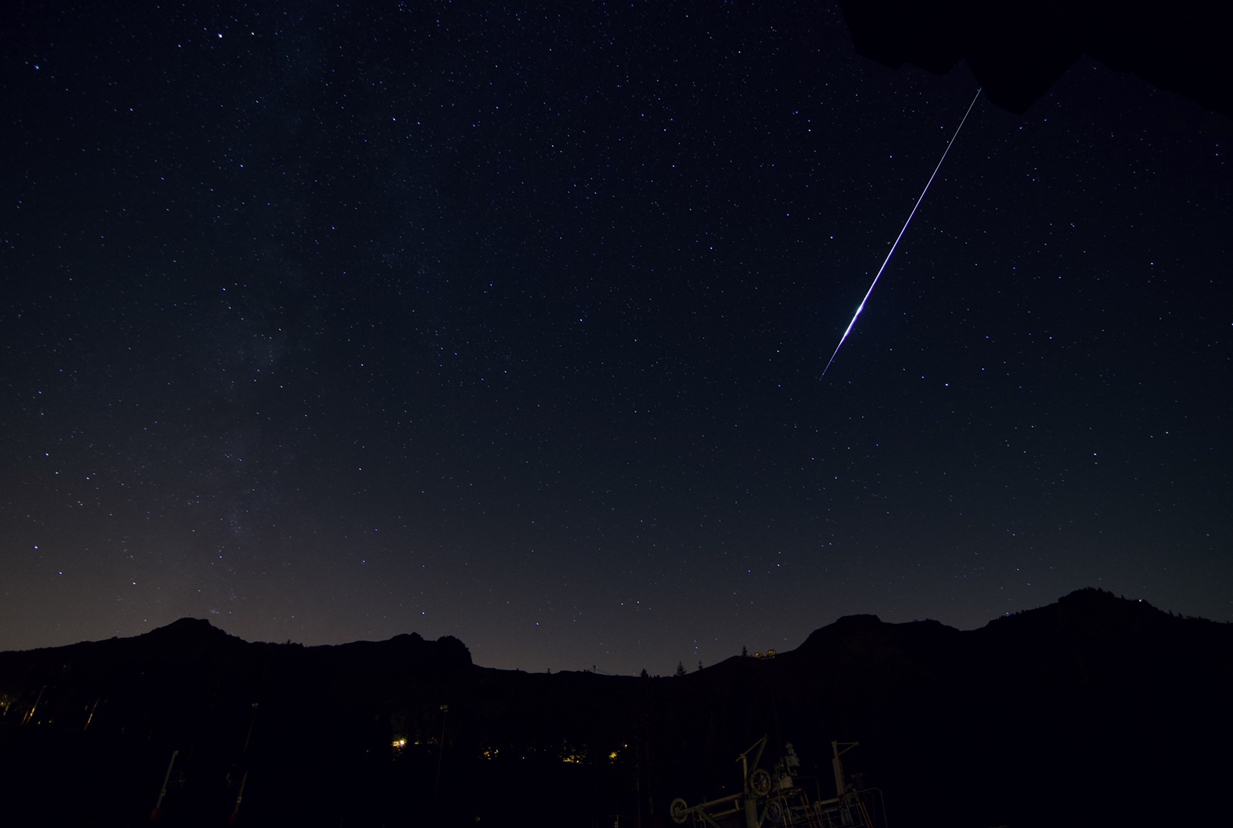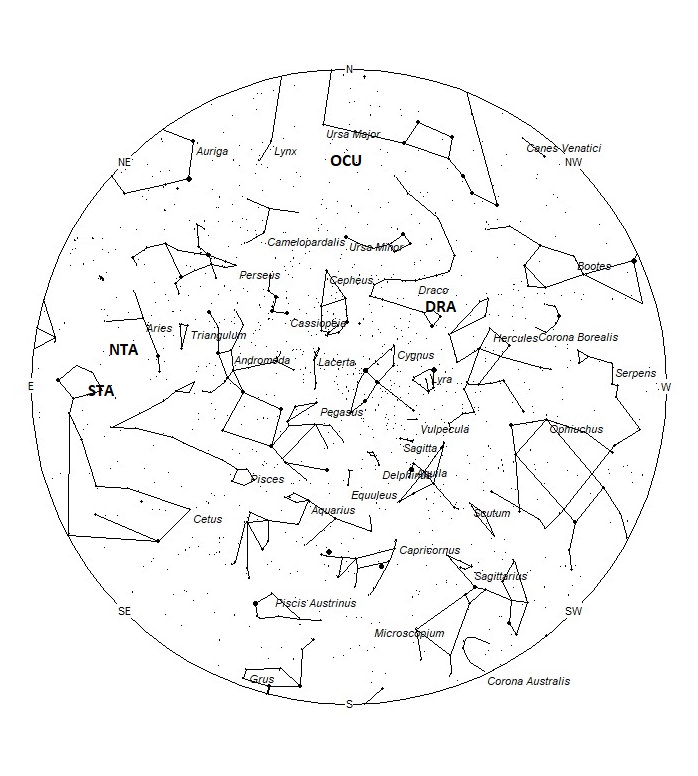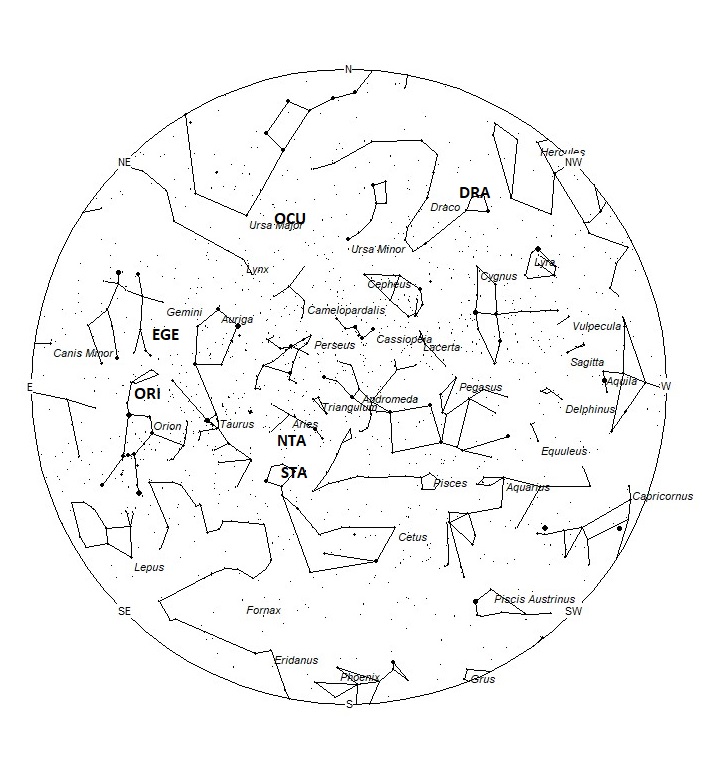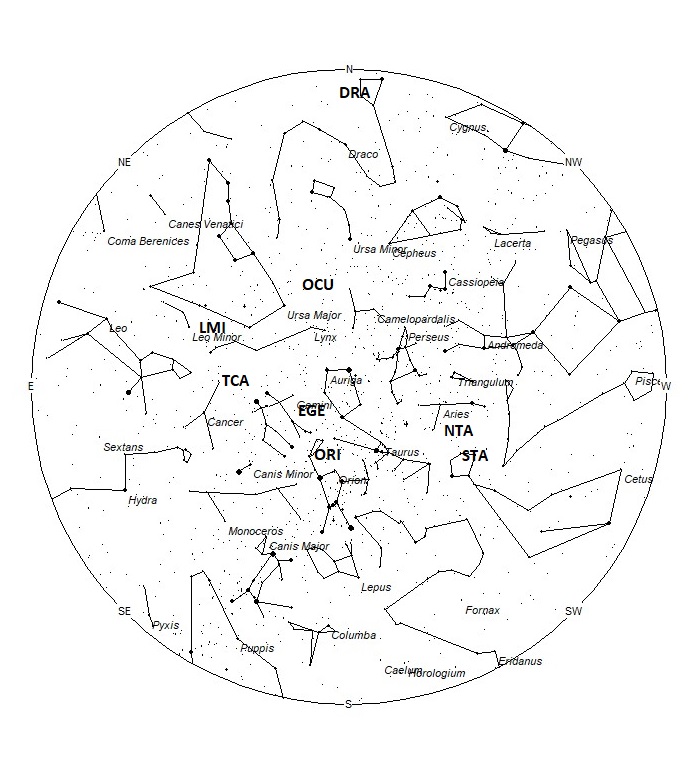
During this period, the moon reaches its first quarter phase on Tuesday October 12th. At that time the moon lies 90 degrees east of the sun and sets near 23:30 local daylight saving time (LDST). This weekend the waxing crescent moon will set during the evening hours and will not interfere with meteor observing, especially during the more active morning hours. The estimated total hourly meteor rates for evening observers this week is near 3 as seen from mid-northern latitudes (45N) and 2 as seen from tropical southern locations (25S). For morning observers, the estimated total hourly rates should be near 15 as seen from mid-northern latitudes (45N) and 12 as seen from tropical southern locations (25S). The actual rates will also depend on factors such as personal light and motion perception, local weather conditions, alertness, and experience in watching meteor activity. Rates are slightly reduced during the evening hours due to moonlight. Note that the hourly rates listed below are estimates as viewed from dark sky sites away from urban light sources. Observers viewing from urban areas will see less activity as only the brighter meteors will be visible from such locations.
The radiant (the area of the sky where meteors appear to shoot from) positions and rates listed below are exact for Saturday night/Sunday morning October 9/10. These positions do not change greatly day to day so the listed coordinates may be used during this entire period. Most star atlases (available at science stores and planetariums) will provide maps with grid lines of the celestial coordinates so that you may find out exactly where these positions are located in the sky. I have also included charts of the sky that display the radiant positions for evening, midnight, and morning. The center of each chart is the sky directly overhead at the appropriate hour. These charts are oriented for facing south but can be used for any direction by rotating the charts to the desired direction. A planisphere or computer planetarium program is also useful in showing the sky at any time of night on any date of the year. Activity from each radiant is best seen when it is positioned highest in the sky, either due north or south along the meridian, depending on your latitude. It must be remembered that meteor activity is rarely seen at the radiant position. Rather they shoot outwards from the radiant, so it is best to center your field of view so that the radiant lies at the edge and not the center. Viewing there will allow you to easily trace the path of each meteor back to the radiant (if it is a shower member) or in another direction if it is sporadic. Meteor activity is not seen from radiants that are located far below the horizon. The positions below are listed in a west to east manner in order of right ascension (celestial longitude). The positions listed first are located further west therefore are accessible earlier in the night while those listed further down the list rise later in the night.
These sources of meteoric activity are expected to be active this week.
.
The Draconids (DRA) are expected to be active on October 8/9 this year. The radiant lies at 17:32 (263) +56. This position lies in southeastern Draco, very close to the position occupied by the faint star known as Kuma (nu Draconis). These meteors are best seen just as soon as it becomes dark on the evening of October 8. With an entry velocity of 21 km/sec., the average Draconid meteor would be of very slow velocity. These meteors are poorly seen from the southern hemisphere due to the low radiant altitude seen from below the equator.
The Southern Taurids (STA) are very complex but recent investigations have revealed two clearly distinct components. The first component represents the early and regular annual activity of Southern Taurids, and the latter component represents the main source of activity and is periodic. The early STA’s are active from September 28 through November 7 and peaks on October 16th. The main component of the STA’s is active from October 13 through December 2 and peaks on November 4*. The center of the large STA radiant is currently located at 02:13 (33) +09. This position lies extreme northwestern Cetus near the spot occupied by the 4th magnitude star known as xi2 Ceti. This radiant is best placed near 0200 LDST, when it lies on the meridian and is located highest in the sky. Rates at this time should be near 3 per hour no matter your location. With an entry velocity of 29 km/sec., the average STA meteor would be of medium-slow velocity.
*The activity of meteor showers recorded by SonotaCo Net video observations 2007–2018, Masahiro Koseki, 2021, https://www.meteornews.net/2021/02/09/february-2021-special-issue-of-emeteornews-online/ Page 170
Members of the Northern Taurids (NTA) should start appearing near Wednesday, October 13. On that date the radiant is located at 02:25 (36) +17. This area of the sky is located in central Aries, 7 degrees southeast of the 2nd magnitude star known as Hamal (alpha Arietis). This radiant is best placed near 0200 LDST, when it lies on the meridian and is located highest in the sky. Maximum activity is not until November 12th so rates at this time should be less than 1 per hour no matter your location. With an entry velocity of 32 km/sec., the average NTA meteor would be of medium-slow velocity.
The Orionids (ORI) are active from September 26 though November 22, with maximum activity occurring on October 21st. The radiant is currently located at 05:48 (087) +15, which places it in eastern Taurus, 8 degrees north of the 1st magnitude orange star known as Betelgeuse (alpha Orionis). This radiant is best placed near 0500 LDST, when it lies on the meridian and is located highest in the sky. Current rates are expected to be near 2 per hour, no matter your location. With an entry velocity of 67 km/sec., the average ORI meteor would be of swift velocity.
The epsilon Geminids (EGE) are active from a radiant located at 06:16 (094) +29. This area of the sky lies in southeastern Auriga, near the spot occupied by the 4th magnitude star known as kappa Aurigae. This area of the sky is best placed during the last dark hour prior to dawn. These meteors are active from September 27 through November 8, with maximum activity occurring on October 18. Since maximum is still one week away, rates at this time are still less than 1 per hour no matter your location. With an entry velocity of 69 km/sec., the average EGE meteor would be of swift velocity.
The A Carinids (CRN) produced an unexpected outburst in 2020*. These meteors are only active October 13-15 with maximum activity expected near 8UT on the 14th. The outburst only lasted 6 hours so it can be easily missed. The radiant is located at 06:35 (099) -54. This area of the sky is located in northwestern Carina, only 3 degrees southeast of the brilliant star known as Canopus (alpha Carinae). These meteors are best seen before dawn from the Southern Hemisphere. The radiant lies too low in the sky to be seen from a majority of the Northern Hemisphere. With an entry velocity of 32 km/sec., the average CRN meteor would be of medium-slow velocity.
*Peter Jenniskens, A Carinids (CRN#842) outburst 2020, Meteor News 2020-6, page 369. https://downloads.meteornews.net/ezine/eMetN2020_6.pdf
The tau Cancrids (TCA) are a weak shower with a long activity period of seven weeks. They are active from September 23 through November 12 with maximum activity occurring on October 22. The radiant currently lies at 08:33 (128) +30, which places it in northern Cancer, 3 degrees northwest of the 4th magnitude star known as Decapoda (iota Cancri A). Expected hourly rates are less than 1 per hour no matter your location. With an entry velocity of 67 km/sec., the average TCA meteor would be of swift velocity.
The October Ursa Majorids (OCU) are a recent discovery by the Japanese group known as SonotaCo. These meteors are active from October 10-20 with maximum activity occurring on October 15th. The radiant is currently located at 08:48 (132) +67. This position lies in northern Ursa Major. The nearest star of note is 23 Ursae Majoris, which lies 7 degrees southeast of the radiant. See the charts for a better idea of the location of this source. This area of the sky is best placed in the sky during the last hour before dawn, when it lies highest above the horizon in a dark sky. Current rates would be most likely less than 1 per hour no matter your location. But near maximum, rates may reach 2 per hour during the late morning hours as seen from the Northern Hemisphere. With an entry velocity of 56km/sec., most activity from this radiant would be of swift speed.
The first of the Leonis Minorids (LMI) are expected near October 13th. On that date the radiant is located at 09:58 (150) +40, which places it in northern Leo Minor, 4 degrees southwest of the pair or 3rd magnitude stars known as mu and lambda Ursae Majoris. The radiant is best placed just before dawn when it lies highest in a dark sky. This shower is better situated for observers situated in the northern hemisphere where the radiant rises far higher into the sky before the start of morning twilight. Current rates would be less than 1 no matter your location. At 62km/sec., the average Leonis Minorid is swift. From my personal experience this minor shower produces a high proportion of bright meteors.
The Daytime Sextantids (DSX) are active from September 22-October 13, with maximum activity occurring on October 3. The current position of the radiant is 10:54 (164) -06. This position lies in southern Leo, 5 degrees southwest of the 4th magnitude star known as phi Leonis. This radiant is best placed near 0100 LST, when it lies on the meridian and is located highest in the sky. Rates at this time should be less than 1 per hour no matter your location. With an entry velocity of 31 km/sec., the average DSX meteor would be of medium-slow velocity. No matter your location, these meteors are difficult to observe as the radiant lies roughly 30 degrees from the sun. Therefore, these meteors may only be seen during the last hour prior to dawn, shooting upward from the eastern horizon.
As seen from the mid-northern hemisphere (45N) one would expect to see approximately 10 sporadic meteors per hour during the last hour before dawn as seen from rural observing sites. Evening rates would be near 2 per hour. As seen from the tropical southern latitudes (25S), morning rates would be near 7 per hour as seen from rural observing sites and 1 per hour during the evening hours. Locations between these two extremes would see activity between the listed figures.
You can keep track of the activity of these meteor showers as well as those beyond the limits of visual observing by visiting the NASA Meteor Shower Portal available at: https://meteorshowers.seti.org/ You can move the sky globe to see different areas of the sky. Colored dots indicate shower meteors while white dots indicate sporadic (random) activity. The large orange disk indicates the position of the sun so little activity will be seen in that area of the sky.
|
SHOWER |
DATE OF MAXIMUM ACTIVITY | CELESTIAL POSITION | ENTRY VELOCITY | CULMINATION | HOURLY RATE | CLASS |
| RA (RA in Deg.) DEC | Km/Sec | Local Daylight Saving Time | North-South | |||
| Draconids (DRA) | Oct 09 | 17:32 (263) +56 | 21 | 18:00 | <1 – <1 | III |
| Southern Taurids (STA) | Oct 16 | 02:13 (33) +09 | 29 | 02:00 | 3 – 3 | II |
| Northern Taurids (NTA) | Nov 12 | 02:25 (36) +17 | 32 | 02:00 | <1 – <1 | II |
| Orionids (ORI) | Oct 21 | 05:48 (087) +15 | 67 | 05:00 | 2 – 2 | I |
| epsilon Geminids (EGE) | Oct 18 | 06:16 (094) +29 | 69 | 06:00 | <1 – <1 | II |
| A Carinids (CRN) | Oct 14 | 06:35 (099) -54 | 32 | 06:00 | ? | III |
| tau Cancrids (TCA) | Oct 22 | 08:33 (128) +30 | 67 | 08:00 | <1 – <1 | IV |
| October Ursa Majorids (OCU) | Oct 15 | 08:48 (132) +67 | 56 | 08:00 | <1 – <1 | IV |
| Leonis Minorids (LMI) | Oct 21 | 09:58 (150) +40 | 62 | 09:00 | <1 – <1 | II |
| Daytime Sextantids (DSX) | Oct 03 | 10:54 (164) -06 | 32 | 10:00 | <1 – <1 | IV |
 American Meteor Society
American Meteor Society



Just saw a beautiful meteor fall ever so slowly. I’m in Gainesville, Georgia. 9:30 Eastern time October 12